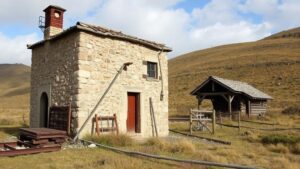Mining Old Mining Camp Equipment Inventories for Artifact Leads
Mining Old Mining Camp Equipment Inventories for Artifact Leads
The study of mining camp equipment inventories offers profound insights into the technological practices and socio-economic conditions of mining communities in the late 19th and early 20th centuries. The analysis of such inventories not only aids in the identification of historical artifacts but also enhances the understanding of mining techniques and community dynamics during the mining boom. This article explores methodologies for sourcing artifact leads from old mining camp equipment inventories, illustrating its importance through concrete examples, and presents an organized framework for researchers in the field.
The Historical Context of Mining Camps
Mining camps emerged in response to the discovery of precious minerals across the United States, notably during the California Gold Rush of 1849 and the subsequent silver rushes that proliferated throughout the West. Camps like Bodie, California–established in 1859–became hubs for miners seeking fortune. The demographic shifts to these regions, including a significant influx of immigrants, catalyzed the establishment of makeshift towns equipped with essential support structures including saloons, general stores, and, importantly, mining operations.
Significant Mining Camps and Their Inventories
Each mining camp operated uniquely, with inventories reflective of local mineralogical conditions and equipment technology. For example, the mining camp of Leadville, Colorado, well known for its silver mining operations, thrived from 1860 until its decline in the 1890s. Significant artifacts from this camp include:
- Mine carts and drilling tools
- Blacksmith equipment used for tool repair
- Candlestick holders from miners lodging quarters
By studying inventories from such camps, researchers can unearth vital leads on equipment types that can further inform on the mining methods employed, and potentially lead to the recovery of unknown artifacts.
Methodologies for Mining Equipment Inventory Analysis
Understanding mining equipment inventories requires a multi-faceted approach that encompasses archival research, field surveys, and technological analysis. Each method provides unique insights that contribute to the overall understanding of mining practices.
Archival Research
Accessing historical documents, such as leases, invoices, and mining company records, is essential for constructing an accurate inventory. In Leadville, for instance, the Larimer County Historical Society maintains extensive mining records that document equipment purchases, their specifications, and usage. Utilizing databases like HistoricArchiver can provide researchers access to these valuable records.
Field Surveys and Artifacts
Field surveys complement archival research by providing direct evidence of equipment in situ. Systematic mapping of mining camp remains can lead to the discovery of previously undocumented artifacts. For example, the Ghost Town of Cripple Creek, Colorado, where surveys led to the discovery of early 1900s steam-driven pumps, showcased how physical exploration could yield informative artifacts.
Technological Integrations
Modern technologies such as Geographic Information Systems (GIS) and 3D scanning have enhanced the analysis of mining equipment. For example, a project in Nevada utilized GIS to digitally archive and visualize the spatial distribution of mining artifacts across historic sites–providing a clearer picture of mining operations over time. Such technologies enable researchers to draw connections between different artifact styles and periods of mining activity.
Conclusion and Future Directions
Mining old mining camp equipment inventories offers a wealth of information for uncovering lost artifacts and understanding the intricate history of mining communities. By employing comprehensive methodologies–archival research, field surveys, and modern technological tools–researchers can advance knowledge in this field significantly. Future studies should continually emphasize the importance of cross-disciplinary approaches, enlisting historians, archaeologists, and technologists to enrich artifact recovery efforts.
In essence, the ongoing assessment of mining camp inventories not only shines a light on the past practices of mining but also cements the cultural heritage that these artifacts represent. Continued efforts in this area promise not only to reveal more about our mining history but also contribute to educational initiatives aimed at preserving this crucial component of industrial heritage.


